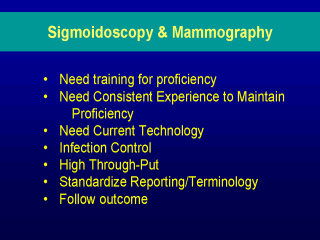 |
Itís very clear that, like
mammography, in order to do a good sigmoidoscopy one needs training, consistent experience
to maintain proficiency, current technology and good infection control. One also really
needs to do a high volume operation. There was a very nice study done by Jim Lewis a few
years ago showing how many sigmoidoscopies a year one would to do to break even based on
Medicare payment. They determined it was at least 60 a year, and I think thatís probably
a gross underestimate. We also need to standardize our reporting and our terminology so
everyone can talk to each other in an efficient way. Something that theyíre starting to
do with breast cancer is go back to mammography centers and see how many of the patients
they called positive really had breast cancer, and how many of the negatives showed up
later in the registry having breast cancer. These are the kind of things that need to be
applied to sigmoidoscopy. My view of this is that the model of performing sigmoidoscopy in
doctorsí offices is wrong. It should be done like mammography where patients go to a
center thatís high volume, equipped, has someone who knows how to do it, and who gets
people in and out and can do ten or twelve in a morning. |
